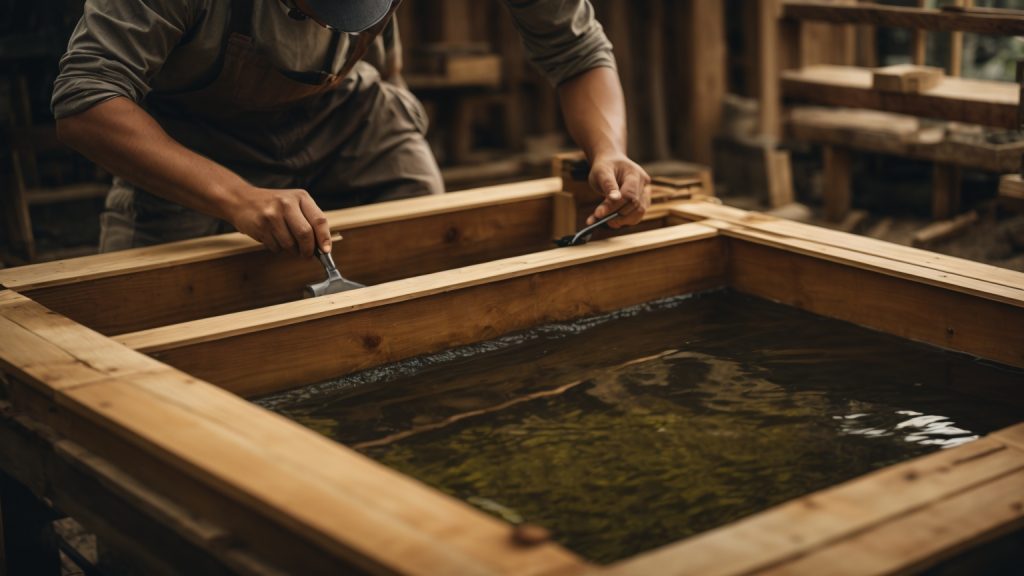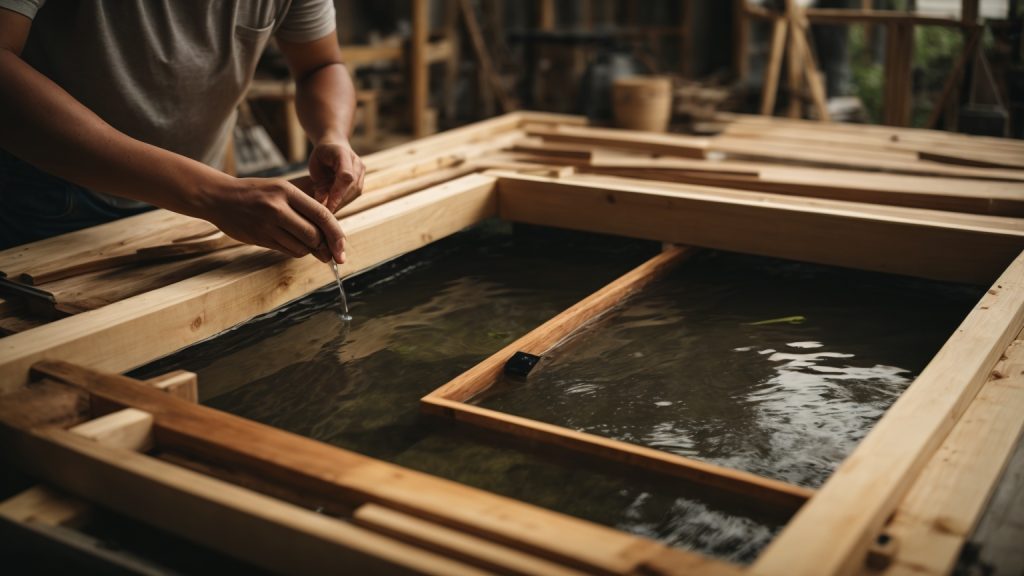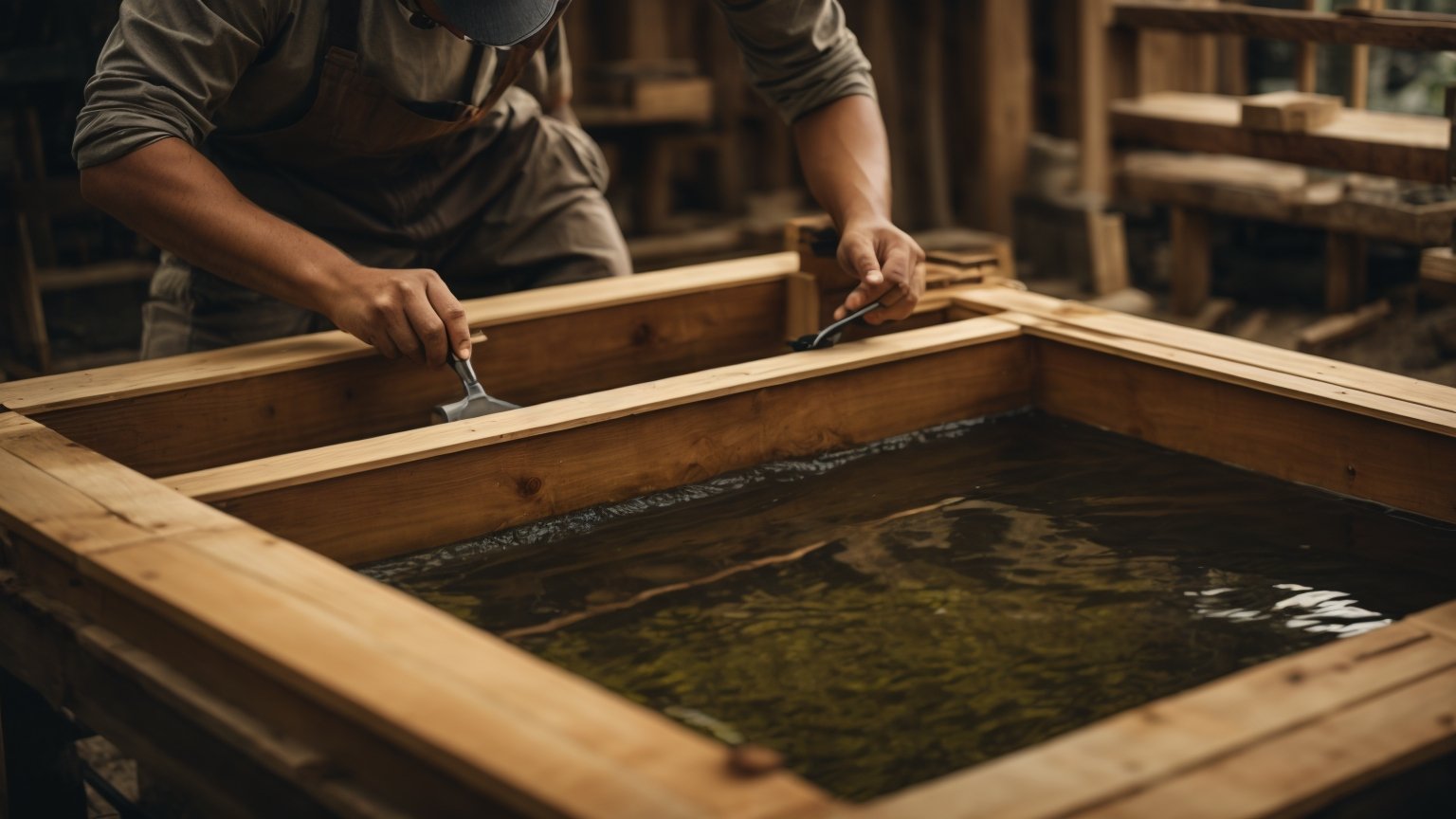Are you interested in adding a beautiful pond to your backyard? Building a wooden pond frame is a great way to create a stunning water feature that will enhance the look of your outdoor space. With a little bit of planning and effort, you can create a pond that is both functional and aesthetically pleasing.
One of the first things you’ll need to consider when building a wooden pond frame is the size and shape of your pond. Think about the space you have available, as well as the type of fish or plants you want to include in your pond. You’ll also need to decide on the depth of your pond, as this will impact the type of liner and pump you’ll need to use. Once you have a clear idea of what you want your pond to look like, you can begin gathering the materials you’ll need to build your wooden frame.
Understanding the Basics of a Wooden Pond Frame

If you’re planning to build a pond in your backyard, a wooden frame is a great option to consider. A wooden pond frame offers a natural look that blends well with the surroundings, and it’s also relatively easy to build. Here are some basics you need to understand before building a wooden pond frame:
Choosing the Right Wood
The first step in building a wooden pond frame is choosing the right wood. You need to choose a wood that is resistant to rot and decay, as it will be exposed to water and moisture. Cedar and redwood are popular choices for wooden pond frames, as they are naturally resistant to rot and decay.
Determining the Size and Shape
The size and shape of your pond frame will depend on the size and shape of your pond. You need to determine the size and shape of your pond before building the frame. You can use a garden hose or spray paint to mark the outline of your pond. Once you have determined the size and shape, you can start building the frame.
Building the Frame
Building a wooden pond frame is relatively easy. You need to start by building the base of the frame, which will support the weight of the pond. You can use pressure-treated lumber for the base, as it is resistant to rot and decay. Once you have built the base, you can start building the walls of the frame. You can use regular lumber for the walls, but make sure to seal it properly to prevent rot and decay.
Installing the Liner
After building the frame, you need to install the liner. A pond liner is a flexible material that is used to hold water in the pond. You can use a rubber liner or a PVC liner for your pond. Make sure to install the liner properly to prevent leaks.
Adding the Finishing Touches
Once you have installed the liner, you can add the finishing touches to your pond. You can add rocks, plants, and other decorations to make your pond look more natural. You can also install a pump and filter to keep the water clean and clear.
Building a wooden pond frame is a fun and rewarding project that can add beauty and serenity to your backyard. With the right tools and materials, you can build a pond that will provide years of enjoyment.
Choosing the Right Wood
When building a wooden frame for your pond, choosing the right type of wood is crucial. You want to choose a wood that is durable, resistant to rot, and can withstand exposure to water. Here are some options to consider:
Cedar
Cedar is a popular choice for building pond frames because it is naturally resistant to decay and rot. It also has a pleasant aroma and is known for its beautiful reddish-brown color. Cedar is a bit more expensive than other types of wood, but it is worth the investment for its durability and aesthetic appeal.
Pressure-Treated Pine
Pressure-treated pine is another popular choice for building pond frames. It is treated with chemicals that make it resistant to decay, insects, and rot. Pressure-treated pine is less expensive than cedar, but it is important to note that the chemicals used in the treatment process can be harmful to fish and other aquatic life. Be sure to use a pond liner to protect your fish from any potential harm.
Redwood
Redwood is a durable and attractive wood that is naturally resistant to decay and insects. It has a rich, reddish color and is often used for outdoor furniture and decks. Redwood is more expensive than pine, but it is a good choice if you want a wood that is both durable and visually appealing.
Other Options
Other woods that can be used for building pond frames include cypress, oak, and teak. These woods are all durable and resistant to decay, but they can be more expensive than other options.
When choosing the right wood for your pond frame, consider your budget, the durability of the wood, and any potential harm to aquatic life. With the right wood and proper construction, your pond frame will provide a beautiful and functional addition to your backyard oasis.
Designing Your Pond Frame
Before you start building your wooden pond frame, you need to design it. This is an essential step that will ensure that your pond is safe, functional, and aesthetically pleasing. Here are some things to consider when designing your pond frame:
Size and Shape
The first thing to consider when designing your pond frame is the size and shape of your pond. You need to decide how big you want your pond to be and what shape you want it to take. The size and shape of your pond will depend on the space available in your yard, the number of fish you want to keep, and your personal preferences.
Materials
The next thing to consider is the materials you will use to build your pond frame. Wood is a popular choice for building pond frames because it is durable, easy to work with, and looks great. However, you need to make sure that the wood you choose is suitable for outdoor use and can withstand exposure to water and other elements.
Depth
Another important factor to consider when designing your pond frame is the depth of your pond. The depth of your pond will depend on the type of fish you want to keep and the climate in your area. Generally, a depth of at least 2 feet is recommended for most fish species.
Filtration and Aeration
Finally, you need to consider how you will filter and aerate your pond. Filtration is important to keep the water clean and clear, while aeration is necessary to provide oxygen to your fish. You can use a variety of filtration and aeration systems, including pumps, filters, and air stones.
By considering these factors when designing your pond frame, you can ensure that your pond is safe, functional, and beautiful. Take your time and plan carefully to create a pond that you will enjoy for years to come.
Materials and Tools Needed
Essential Materials
Building a wooden pond frame requires certain materials to ensure its durability and safety for your aquatic life. Here are the essential materials you will need:
| Materials | Quantity |
|---|---|
| Pressure-treated lumber | Depends on the size of the pond |
| Pond liner | Depends on the size of the pond |
| Rebar stakes | 8-10 pieces |
| Gravel | Enough to cover the bottom of the pond |
| Screws | Enough to secure the lumber |
Pressure-treated lumber is recommended for building the frame as it is resistant to rot and insect damage. The pond liner will serve as a barrier between the wood and water, preventing the wood from rotting. Rebar stakes will be used to secure the frame to the ground, and gravel will provide a stable base for the pond liner. Screws will be used to join the lumber together.
Required Tools
To build a wooden pond frame, you will need the following tools:
- Circular saw
- Power drill
- Level
- Tape measure
- Shovel
- Wheelbarrow
- Hammer
- Rubber mallet
- Utility knife
- Safety glasses
- Gloves
A circular saw will be used to cut the lumber to the appropriate size. A power drill will be used to make holes for the screws and to attach the rebar stakes. A level will ensure that the frame is even and balanced. A tape measure will be used to measure the dimensions of the frame and the pond liner. A shovel and wheelbarrow will be needed to move the gravel and soil. A hammer and rubber mallet will be used to secure the rebar stakes and adjust the frame. A utility knife will be used to trim the pond liner. Finally, safety glasses and gloves are recommended to protect yourself while working with the tools and materials.
Preparation Steps
Before you start building your wooden pond frame, there are a few preparation steps that you need to take. These steps will help ensure that your pond is safe for your fish and will last for years to come.
Site Preparation
The first step in preparing for your wooden pond frame is to choose the right location. You want to choose a location that is level and has good drainage. Avoid areas that are prone to flooding or have poor drainage.
Once you have chosen your location, you need to prepare the site. This involves removing any grass or vegetation from the area where your pond will be. You can use a shovel or a sod cutter to remove the grass.
After you have removed the grass, you need to level the area. You can use a rake or a shovel to level the area. Make sure that the area is level and smooth.
Wood Treatment
The next step in preparing for your wooden pond frame is to treat the wood. You want to use wood that is resistant to rot and decay. Cedar and redwood are good choices for building a wooden pond frame.
Before you start building your pond frame, you need to treat the wood with a wood preservative. This will help protect the wood from rot and decay. You can use a brush or a sprayer to apply the wood preservative.
Make sure that you apply the wood preservative to all sides of the wood, including the ends. You should also let the wood dry for at least 24 hours before you start building your pond frame.
By following these preparation steps, you can ensure that your wooden pond frame is safe and will last for years to come.
Building the Frame

Building a wooden frame for your pond is a great way to create a sturdy and long-lasting structure that will keep your pond safe and secure. In this section, we will go over the steps involved in building a wooden pond frame, including the base construction, side construction, and top construction.
Base Construction
The first step in building a wooden pond frame is constructing the base. This is the foundation of your frame and should be built to last. Here are the steps involved in building the base:
- Measure the dimensions of your pond and add a few inches to each side to ensure that the frame will be large enough to support it.
- Cut four pieces of pressure-treated lumber to the length of your pond plus the additional inches you added in step 1.
- Lay the four pieces of lumber on a flat surface and attach them together at the corners using wood screws or nails.
- Use a level to ensure that the base is even and adjust as necessary.
Side Construction
Once the base is complete, you can move on to constructing the sides of the frame. This will provide support for the pond liner and prevent it from collapsing. Here are the steps involved in building the sides:
- Cut four pieces of pressure-treated lumber to the height of your desired frame.
- Attach the four pieces of lumber to the corners of the base using wood screws or nails.
- Use a level to ensure that the sides are even and adjust as necessary.
Top Construction
The final step in building the wooden pond frame is constructing the top. This will provide a sturdy surface for the pond liner to rest on. Here are the steps involved in building the top:
- Cut four pieces of pressure-treated lumber to the length of your pond plus the additional inches you added in step 1 of the base construction section.
- Attach the four pieces of lumber to the top of the side pieces using wood screws or nails.
- Use a level to ensure that the top is even and adjust as necessary.
Congratulations! You have now completed the construction of your wooden pond frame. With proper maintenance and care, your frame should last for many years to come.
Adding the Pond Liner
Now that you have built the wooden frame for your pond, it’s time to add the pond liner. Here are the steps to follow:
- Lay the Underlayment: Before adding the pond liner, it’s important to lay the underlayment first. This will help protect the liner from any sharp objects that may damage it. You can use sand, old carpet, or even newspapers as underlayment.
- Position the Pond Liner: Once the underlayment is in place, it’s time to position the pond liner. Carefully lay it over the underlayment and make sure it’s centered over the pond.
- Stretch the Pond Liner: Once the pond liner is in place, it’s important to stretch it evenly. This will help prevent any wrinkles or folds that may trap debris or cause leaks. You can use rocks or other heavy objects to hold the liner in place as you stretch it.
- Secure the Pond Liner: When the pond liner is stretched evenly, it’s time to secure it to the wooden frame. You can use adhesive to attach the liner to the wood. However, it’s important to note that pond liner materials like RPE and RPP are hard to adhere securely to wood with adhesive alone. To attach your pond liner to wood, you can also use screws or nails.
- Trim the Excess Liner: Once the pond liner is secured in place, it’s time to trim the excess liner. Use a sharp pair of scissors or a utility knife to carefully trim the excess liner around the edges of the pond.
By following these steps, you can successfully add the pond liner to your wooden pond frame. With the liner in place, you can now add water to your pond and start enjoying your new backyard oasis!
Maintaining Your Wooden Pond Frame
Building a wooden pond frame can be a great addition to your backyard, but it’s important to keep it well-maintained to ensure its longevity. Here are some tips on how to maintain your wooden pond frame:
Regular Cleaning
One of the most important things you can do to maintain your wooden pond frame is to keep it clean. Regularly remove any debris or leaves that fall into the pond, as they can cause blockages and damage to your pump. Use a skimmer net to remove debris from the surface of the water, and a pond vacuum to clean the bottom of the pond.
Check for Leaks
It’s important to check your pond for leaks regularly. Look for any signs of water loss, such as a drop in water level, wet areas around the pond, or visible cracks. If you find a leak, it’s important to repair it as soon as possible to prevent further damage. You can use a pond sealant to fix small leaks, but larger leaks may require professional help.
Maintain Water Quality
Maintaining good water quality is essential for the health of your fish and plants. Test the water regularly to ensure that the pH balance is correct and that the water is not too acidic or alkaline. You should also add beneficial bacteria to the pond to help break down organic matter and keep the water clean.
Protect Your Pond from Wildlife
Wildlife such as raccoons and herons can cause damage to your pond and harm your fish. To protect your pond, install a net over the top to prevent wildlife from accessing it. You can also add floating plants to provide cover for your fish and discourage predators.
By following these tips, you can keep your wooden pond frame in great condition and enjoy it for years to come.
